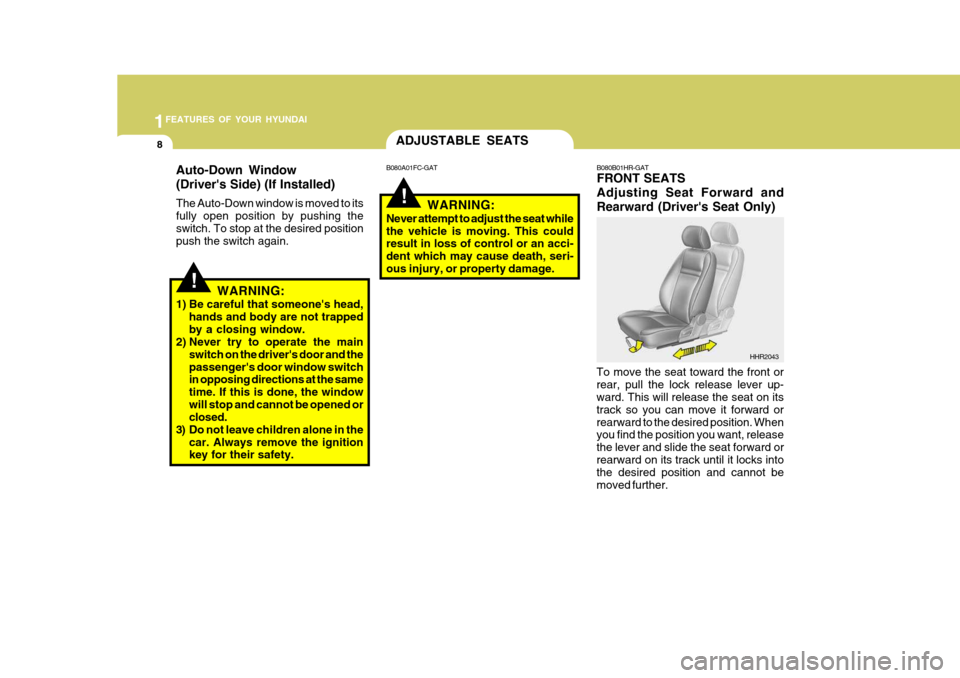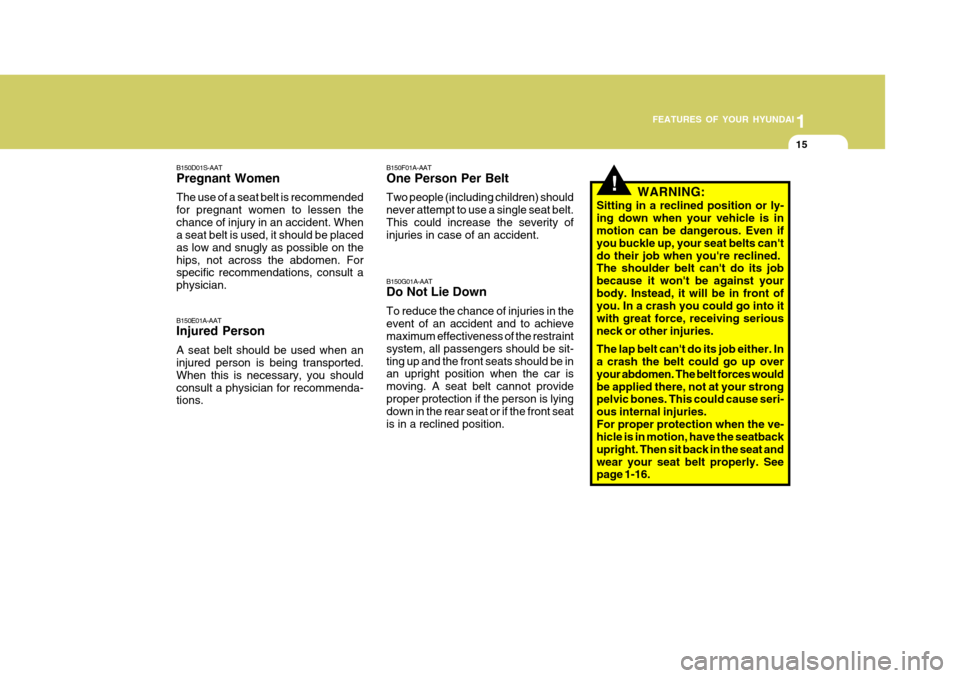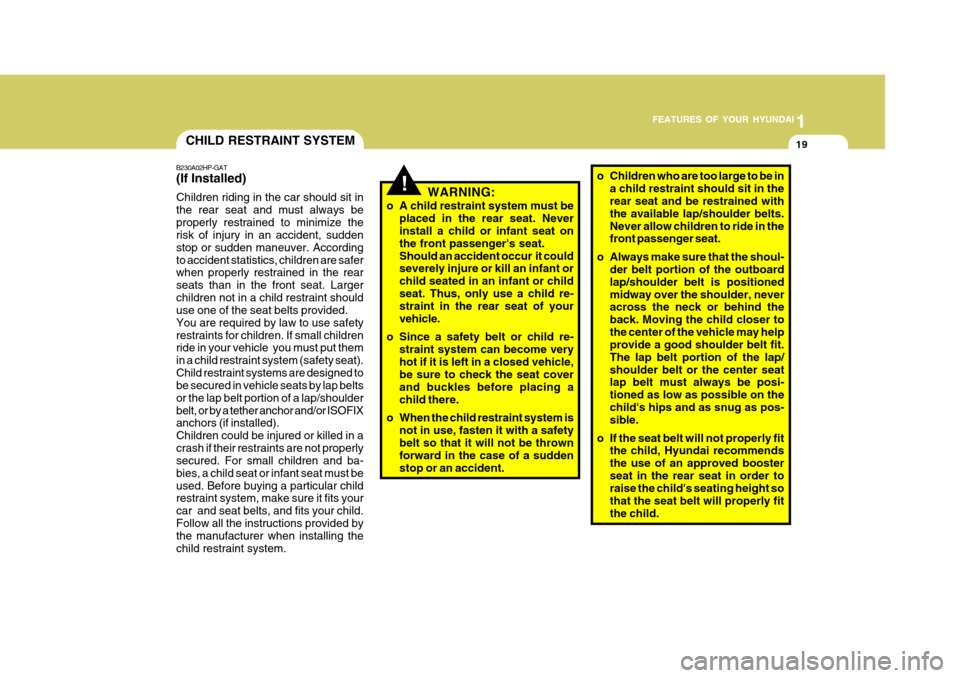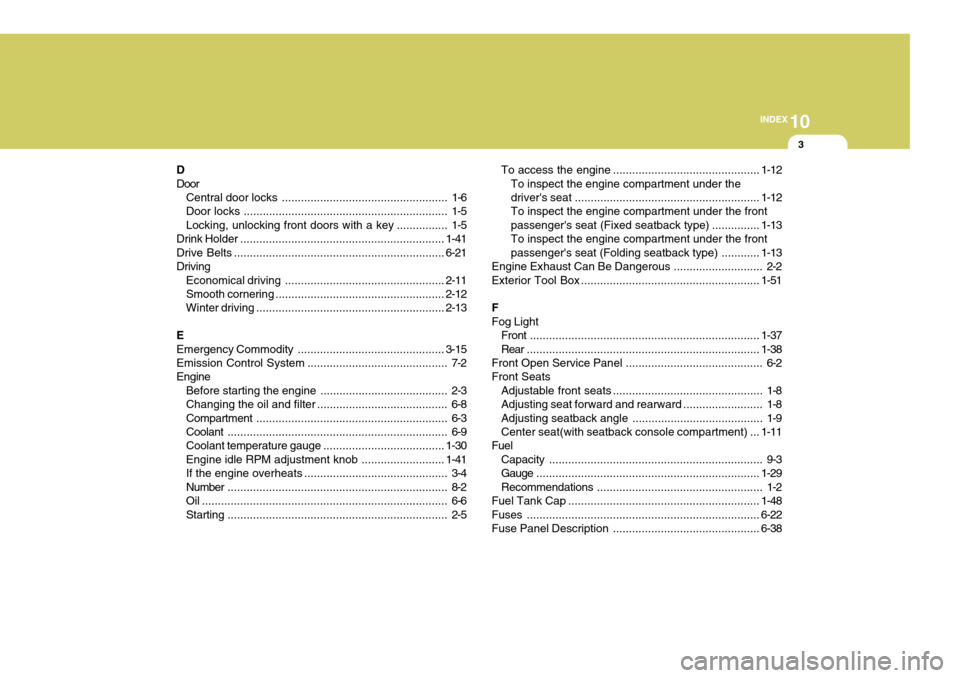2011 Hyundai H-100 Truck seats
[x] Cancel search: seatsPage 20 of 211

1FEATURES OF YOUR HYUNDAI
8
!
ADJUSTABLE SEATS
To move the seat toward the front or rear, pull the lock release lever up- ward. This will release the seat on its track so you can move it forward orrearward to the desired position. When you find the position you want, release the lever and slide the seat forward orrearward on its track until it locks into the desired position and cannot be moved further.
B080A01FC-GAT
B080B01HR-GAT
FRONT SEATS Adjusting Seat Forward andRearward (Driver's Seat Only)
WARNING:
Never attempt to adjust the seat while the vehicle is moving. This could result in loss of control or an acci- dent which may cause death, seri-ous injury, or property damage.
HHR2043
!
Auto-Down Window (Driver's Side) (If Installed) The Auto-Down window is moved to its fully open position by pushing theswitch. To stop at the desired position push the switch again.WARNING:
1) Be careful that someone's head, hands and body are not trapped by a closing window.
2) Never try to operate the main
switch on the driver's door and thepassenger's door window switch in opposing directions at the same time. If this is done, the windowwill stop and cannot be opened or closed.
3) Do not leave children alone in the car. Always remove the ignitionkey for their safety.
Page 27 of 211

1
FEATURES OF YOUR HYUNDAI
15
B150D01S-AAT Pregnant Women The use of a seat belt is recommended for pregnant women to lessen thechance of injury in an accident. When a seat belt is used, it should be placed as low and snugly as possible on thehips, not across the abdomen. For specific recommendations, consult a physician. B150E01A-AAT Injured Person A seat belt should be used when an injured person is being transported. When this is necessary, you shouldconsult a physician for recommenda- tions. B150G01A-AAT Do Not Lie Down To reduce the chance of injuries in the event of an accident and to achieve maximum effectiveness of the restraint system, all passengers should be sit-ting up and the front seats should be in an upright position when the car is moving. A seat belt cannot provideproper protection if the person is lying down in the rear seat or if the front seat is in a reclined position.
B150F01A-AAT One Person Per Belt Two people (including children) should never attempt to use a single seat belt.This could increase the severity of injuries in case of an accident.
!WARNING:
Sitting in a reclined position or ly- ing down when your vehicle is in motion can be dangerous. Even if you buckle up, your seat belts can'tdo their job when you're reclined. The shoulder belt can't do its job because it won't be against yourbody. Instead, it will be in front of you. In a crash you could go into it with great force, receiving seriousneck or other injuries. The lap belt can't do its job either. In a crash the belt could go up over your abdomen. The belt forces wouldbe applied there, not at your strong pelvic bones. This could cause seri- ous internal injuries.For proper protection when the ve- hicle is in motion, have the seatback upright. Then sit back in the seat andwear your seat belt properly. See page 1-16.
Page 31 of 211

1
FEATURES OF YOUR HYUNDAI
19
WARNING:
o A child restraint system must be placed in the rear seat. Never install a child or infant seat on the front passenger's seat.Should an accident occur it could severely injure or kill an infant or child seated in an infant or childseat. Thus, only use a child re- straint in the rear seat of your vehicle.
o Since a safety belt or child re- straint system can become veryhot if it is left in a closed vehicle, be sure to check the seat cover and buckles before placing achild there.
o When the child restraint system is not in use, fasten it with a safety belt so that it will not be thrown forward in the case of a suddenstop or an accident.!
CHILD RESTRAINT SYSTEM
B230A02HP-GAT (If Installed) Children riding in the car should sit in the rear seat and must always beproperly restrained to minimize the risk of injury in an accident, sudden stop or sudden maneuver. Accordingto accident statistics, children are safer when properly restrained in the rear seats than in the front seat. Largerchildren not in a child restraint should use one of the seat belts provided. You are required by law to use safetyrestraints for children. If small children ride in your vehicle you must put them in a child restraint system (safety seat).Child restraint systems are designed to be secured in vehicle seats by lap belts or the lap belt portion of a lap/shoulderbelt, or by a tether anchor and/or ISOFIX anchors (if installed). Children could be injured or killed in acrash if their restraints are not properly secured. For small children and ba- bies, a child seat or infant seat must beused. Before buying a particular child restraint system, make sure it fits your car and seat belts, and fits your child.Follow all the instructions provided by the manufacturer when installing the child restraint system.
o Children who are too large to be in a child restraint should sit in the rear seat and be restrained with the available lap/shoulder belts.Never allow children to ride in the front passenger seat.
o Always make sure that the shoul- der belt portion of the outboard lap/shoulder belt is positionedmidway over the shoulder, never across the neck or behind the back. Moving the child closer tothe center of the vehicle may help provide a good shoulder belt fit. The lap belt portion of the lap/shoulder belt or the center seat lap belt must always be posi- tioned as low as possible on thechild's hips and as snug as pos- sible.
o If the seat belt will not properly fit the child, Hyundai recommends the use of an approved boosterseat in the rear seat in order to raise the child's seating height so that the seat belt will properly fitthe child.
Page 33 of 211

1
FEATURES OF YOUR HYUNDAI
21
B230H01HR-GAT Child Seat Restraint Suitability For Seat Position Use child safety seats that have been officially approved and are appropriatefor your children. When using the child safety seats, refer to the following table.
PassengerCenter
Age Group Seating PositionPassenger
Outboard
0 : Up to 10 kg (0 ~ 9 months)0+ : Up to 13 kg(0 ~ 2 years)I : 9kg to 18kg(9 months ~4 years)II & III : 15kg to36kg (4 ~12 years) X
U
UF X X X
UF X
If you need to tighten the belt, pull more webbing toward the retractor. When youunbuckle the seat belt and allow it to retract, the retractor will automatically revert back to its normal seated pas-senger emergency locking usage con- dition. NOTE:
o Before installing the child re-
straint system, read the instruc- tions supplied by the child re- straint system manufacturer.
o If the seat belt does not operate as described, have the systemchecked immediately by yourauthorized Hyundai dealer. U : Suitable for "universal" category
restraints approved for use in thismass group (PEG-PEREGO E13 03 0010 083779)
UF: Suitable for forward-facing "univer- sal" category restraints approvedfor use in this mass group (ROMER E1 03301133)
X : Seat position not suitable for chil- dren in this mass group
Page 138 of 211

4
CORROSION PREVENTION AND APPEARANCE CARE
5
4
CORROSION PREVENTION AND APPEARANCE CARE
5
E030D01A-AAT When to Wax Again You should polish and wax the car again when water no longer beads ona clean surface but spreads out over a larger area. E030E01A-AAT Maintaining Bumpers Special precautions must be observed to preserve the appearance of the bumpers on your Hyundai. They are:
o Be careful not to spill battery elec- trolyte or hydraulic brake fluid on the bumpers. If you do, wash it off im- mediately with clear water.
o Be gentle when cleaning the bumper surfaces. They are made of softplastic and the surface can be dam- aged if mistreated. Do not use abra-sive cleaners. Use warm water and mild soap or car-washing solution.
o Do not expose the bumpers to high temperatures. For example, if youhave your car repainted, do not leave the bumpers on the car if thecar is going to be placed in a high- temperature paint booth.
E030B01A-AAT Spot Cleaning Don't use gasoline, strong solvents or corrosive cleaning agents. These candamage the finish of the car. To re- move road tar, use turpentine on a clean, soft cloth or commercially avail-able bug and tar remover. Be gentle. To remove dead insects or tree sap, use warm water and mild soap or car-washing solution. Soak the spot and rub gently. If the paint has lost its luster, use a commercial car-cleaningpolish.
E030C01A-AAT Polishing and Waxing Always wash and dry the car before polishing or waxing or using a combi- nation cleaner and wax. Use a good quality commercial product and followthe manufacturer's directions on the container. Polish and wax the bright trim pieces as well as the paint.CLEANING THE INTERIOR
E040A01A-AAT To Clean the Vinyl Upholstery To clean the vinyl upholstery, first re- move loose dirt and dust with a vacuumcleaner. Then apply a solution of mild soap or detergent and water using a clean sponge or soft cloth. Allow this tostay on the surface to loosen the dirt, then wipe with a clean damp sponge or cloth. If all the dirt stains are not re-moved, repeat this procedure until the upholstery is clean. Do not use gaso- line, solvent, paint thinner or otherstrong cleaners. E040B01HR-AAT To Clean the Leather Upholstery
CAUTION:
When cleaning leather products (steering wheel, seats etc.), use neu- tral detergents or low alcohol con- tent solutions. If you use high alco-hol content solutions or acid/alka- line detergents, the color of the leather may fade or the surface may getstripped off.
!
o To prevent damage to the plastic
parts, do not clean with chemical solvents or strong detergents.
Page 208 of 211

10
INDEX
3
D Door Central door locks .................................................... 1-6
Door locks ................................................................ 1-5Locking, unlocking front doors with a key ................ 1-5
Drink Holder ................................................................ 1-41
Drive Belts .................................................................. 6-21
Driving Economical driving .................................................. 2-11
Smooth corneri ng ..................................................... 2-12
Winter driving ........................................................... 2-13
E
Emergency Commodity .............................................. 3-15
Emission Contro l System ............................................ 7-2
Engine
Before starting the engine ........................................ 2-3
Changing the oil and filter ......................................... 6-8Compartment ............................................................ 6-3
Coolant ..................................................................... 6-9
Coolant temperature gauge ......................................1-30
Engine idle RPM adjustment knob ..........................1-41
If the engine overheats ............................................. 3-4
Number ..................................................................... 8-2
Oil ............................................................................. 6-6Starting ..................................................................... 2-5 To access the
engine .............................................. 1-12
To inspect the engine compartment under the
driver's seat .......................................................... 1-12
To inspect the engine compartment under the frontpassenger's seat (Fixed seatback type) ............... 1-13
To inspect the engine compartment under the frontpassenger's seat (Fol ding seatback type) ............ 1-13
Engine Exhaust Can Be Dangerous ............................ 2-2
Exterior Tool Box ........................................................ 1-51
FFog Light Front ........................................................................ 1-37
Rear ......................................................................... 1-38
Front Open Service Panel ........................................... 6-2
Front Seats Adjustable front seats ............................................... 1-8
Adjusting seat forward and rearward ......................... 1-8
Adjusting seatback angle ......................................... 1-9
Center seat(with seatback console compartment) ... 1-11
Fuel
Capacity ................................................................... 9-3
Gauge ...................................................................... 1-29
Recommendations .................................................... 1-2
Fuel Tank Cap ............................................................ 1-48
Fuses ......................................................................... 6-22
Fuse Panel Description .............................................. 6-38